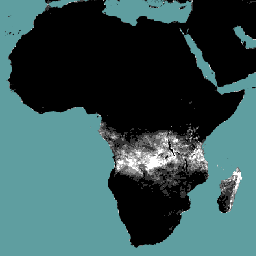
- זמינות קבוצת הנתונים
- 2009-01-01T00:00:00Z–2025-12-11T00:00:00Z
- ספק קבוצת הנתונים
- הארגון למזון וחקלאות של האו"ם
- קצב
- 10 ימים
- תגים
תיאור
רכיב הנתונים של היירוט (I) (עשרוני, במילימטרים ליום) מייצג את האידוי של מי גשם שיירטו מחופת הצמחייה. התהליך שבו מי הגשמים נלכדים על ידי העלים נקרא יירוט. חלק מהגשם שנקלט יתאדה שוב. הערך של כל פיקסל מייצג את כמות המים הממוצעת שמתאדה מדי יום במהלך הדקדה הספציפית.
תחום תדרים
גודל הפיקסל
248.2 מטרים
תחום תדרים
| שם | יחידות | קנה מידה | גודל הפיקסל | תיאור |
|---|---|---|---|---|
L1-I-D |
מ"מ | 0.1 | מטרים | Interception (Dekadal) [mm] |
תנאים והגבלות
תנאים והגבלות
הארגון למזון וחקלאות של האו"ם (FAO) מוסמך לאסוף, לנתח, לפרש ולהפיץ מידע שקשור לתזונה, למזון ולחקלאות. לכן, הארגון מפרסם מספר מסדי נתונים בנושאים שקשורים למנדט שלו, ומעודד את השימוש בהם למטרות מחקר ולמטרות מדעיות. בהתאם לעקרונות של פתיחות ושיתוף שמופיעים ברישיון לנתונים פתוחים עבור מסדי נתונים סטטיסטיים, ובהתאם למנדט של FAO, הארגון מעמיד בחינם לרשותה של קהילת המשתמשים נתונים מ-Water Productivity Open Access Portal (הפורטל בגישה פתוחה לנושאי פרודוקטיביות של שימוש במים – WaPOR), כחלק מ-AQUASTAT – מערכת המידע הגלובלית של FAO בנושאי מים וחקלאות.
ציטוטים ביבליוגרפיים
FAO 2023. WaPOR Database Methodology: Level 1. Remote Sensing for Water Productivity Technical Report: Methodology Series. Rome, FAO. 72 דפים.
FAO 2023. WaPOR V3 Database Methodology. Remote Sensing for Water Productivity Technical Report: Methodology Series. Rome, FAO. https://www.fao.org/3/cc6964en/cc6964en.pdf
סיור עם פלטפורמת Earth Engine
Code Editor (JavaScript)
var coll = ee.ImageCollection('FAO/WAPOR/3/L1_I_D'); var image = coll.first(); Map.setCenter(17.5, 20, 3); Map.addLayer(image, {min: 0, max: 50});
